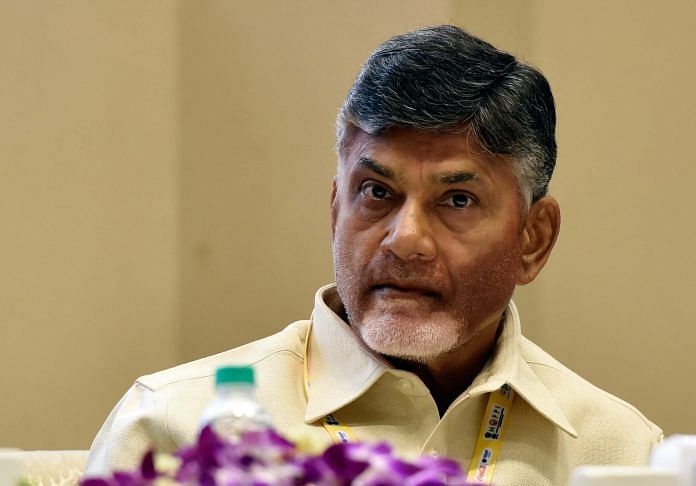Within a year of its launch, the Telugu Desam Party unseated the Congress government from Andhra after 27 years in office.
New Delhi: The Telugu Desam Party (TDP) has been around as a political party for less than four decades and even though a regional party limited to one region, it has frequently made national headlines.
The TDP arrived on the political scene in Andhra Pradesh in 1982, as a star that had the audiences rooting for it from the get-go. It was formed by celebrated Telugu cinema icon N.T. Rama Rao, or NTR, as a vehicle of local pride to fight the state’s neglect by the Congress, then leading the government in Andhra Pradesh as well as at the Centre.
Since the state was formed in 1956, Andhra had only been led by Congress governments.
Ahead of assembly elections in 1983, NTR, among the first politicians to use the rath yatra as a campaign tool, travelled the length and breadth of the state to connect with his people. It worked. The TDP stormed to power, winning 201 of the state’s 294 seats (it contested from 290). The Congress’s tally dwindled to 60.
Nine months after his party’s launch, NTR assumed office as chief minister.
A rocky start
Tumult marked the TDP’s early days in government.
In August 1984, while NTR was in the US for heart surgery, he was removed as chief minister by the then governor Ramlal in an attempted coup. The governor made NTR’s finance minister, N. Bhaskara Rao , chief minister instead.
Enraged, NTR returned and boarded his ‘Chaitanya Ratham’ again to crusade against his undemocratic removal. He campaigned extensively, and earned the support of several anti-Congress parties, including the BJP, the Left Front and the DMK.
Under immense pressure owing to the united attack and the massive popular upsurge, the Congress government at the Centre relented. Indira Gandhi, then the Prime Minister, recalled Ramlal and appointed a new governor, Congress veteran Shankar Dayal Sharma, who had NTR reinstated 31 days after his removal.
In the 1984 general elections, held after Indira Gandhi’s assassination, the Congress party registered wins all over the country, except in Andhra Pradesh, where the TDP won by a huge margin. With 30 of the state’s 42 seats, the TDP arrived on the national stage as the first regional party ever to form the opposition in the Lok Sabha. It wasn’t yet three years old.
In 1985, NTR called for fresh state elections. He won. His second tenure as chief minister was relatively peaceful. However, in 1989, the TDP was hit by anti-incumbency and the Congress was back.
NTR used 1989 to establish himself as well as the TDP as larger political players, and actively took part in national politics. He formed a coalition of anti-Congress parties, the National Front, including the DMK, the Congress Party (socialist) and the Janata Dal. The National Front, led by NTR, was also supported by the BJP and the Left Front. In Andhra Pradesh, the TDP served the role of the main opposition.
In 1993, NTR married Lakshmi Parvathi, who he was apparently grooming to take over as the leader of the TDP. The choice of successor divided the party, with a large section of the TDP dissenting.
The next year, the party came back to power in the state in coalition with the Left Front. This was the beginning of NTR’s third and final term as chief minister, as he led a deeply divided party.
NTR’s son-in-law, Nara Chandrababu Naidu, an important member of the party, had been involved in politics since his 20s. At 28, he was made a minister in the state’s then Congress government.
Naidu played a pivotal role in the resistance against Bhaskara Rao’s 1984 coup attempt. But things were different a decade later. Naidu was reported to be wary of Parvathi, and believed the party would disintegrate under her. And so, in 1995, NTR faced another coup, this one led by his son-in-law.
Most TDP members, including NTR’s sons, sided with Naidu. Power within the party shifted to Naidu, and NTR’s faction came to be known as TDP (NTR). In 1996, NTR died, and Parvathi took over as the leader of TDP (NTR), which no longer had much representation in the state assembly.
In the next election, the TDP won again, and Naidu remained chief minister. After that, however, the party’s electoral fortunes began to decline — the strengthening statehood movement for Telangana, spearheaded by the Telangana Rashtra Samithi (TRS), being one of the biggest reasons. The TRS was founded by K. Chandrashekara Rao (KCR), a former TDP member who quit the party in 2000 over “differences” with the brass.
Party opinion on the demand for Telangana was divided, and this further fragmented the party. The emergence of local parties (which later merged with the Congress) also eroded the TDP’s voter base in regions like coastal Andhra.
In the 2004 state elections, the TDP allied with the BJP, but lost to the Congress. Y.S. Rajasekhara Reddy (YSR) became chief minister, under whom the party defeated a TDP-TRS alliance to win the 2009 polls too.
At the national level, in the 1990s, Naidu headed the 13-party United Front, which led the central government from 1996-1998. From 1998 to 2004, the TDP supported the BJP-led NDA at the Centre. After the 2004 elections, however, the party severed ties with the NDA and joined the Third Front, a coalition of parties against the Congress and the BJP.
In the 2014 state elections, the TDP again allied with the BJP. The state was bifurcated in June 2014, and the TDP-BJP alliance formed the government in Andhra Pradesh. Now the party is on the verge of quitting the NDA over Andhra Pradesh not being given special status, and its wheel of political positioning comes another circle.



